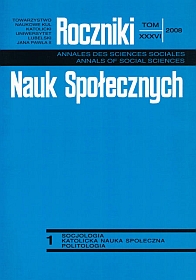The Ethnic Structure of Poland’s Population
Abstract
The article presents the results of the census conducted in April 2002. It contains statistical information referring to the ethnic composition of Poland’s population and the languages used by Polish citizens. The results of the census have shown that 38,230,100 people live on the territory of Poland. The Polish nationality was declared by 36,983,700 people. Another ethnic option was chosen by 471,500 people, that is by 1.2% of the whole of the population of the country. Silesians proved to be the greatest minority (173,200), Germans (152,900), Belorussians (48,700) and Ukrainians (31,000). Other ethnic groups proved to be less numerous. The author offers an interpretation of the census results. He pays a special attention to the problem of the Silesian minority, that is not considered a national group by specialists. He shows that the group has been undergoing Polish and German influences for many centuries. Silesians have spoken Polish and they have been faithful to Catholicism. This connected them to Poland. However, on the other hand they have accepted German civilization-cultural patterns. In the next part of the article data referring to the language spoken by the citizens of Poland are presented. Also in this domain complete supremacy of the Polish language is found, as 97.8% of Poland’s population recognize Polish as the language they speak at home. The second most popular language turns out to be German (206,600 people – 0.5% of the country’s population). Other languages play a marginal role. The national data compared to the ethnic structure are a basis for a territorial analysis. The author has made an analysis of places particular ethnic group live in and referred them to territorial administration units of the province and common level. He has proven that the German population is concentrated in Opole Silesia, and the Belorussian population in Podlasie, in the area of the Białowieska Forest. The presented statistical information and their introductory interpretation have confirmed the well-known fact that Poland is a mono-ethnic country. The role of ethnic and language minorities is only slight. The ethnic and language conformity is also connected with Poland’s religious specificity. A predominant part of the citizens of Poland has traditional bonds with Catholicism.
Copyright (c) 2008 Roczniki Nauk Społecznych

This work is licensed under a Creative Commons Attribution-NonCommercial-NoDerivatives 4.0 International License.


